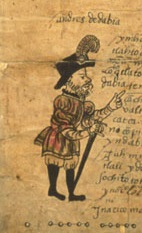Andres de Tapia was a Spanish conquistador under the command of Hernan Cortes during the Conquest of Mexico. Like many of the Spanish conquistadors he was born in Estremadura, Spain. While at Cozumel, Tapia was the first man to spot the lost Spaniard who had lived among the Maya.

He wrote an account of the Conquest with the catchy title of RELACIÓN DE ALGUNAS COSAS DE LAS QUE ACAECIERON AL MUY ILUSTRE SEÑOR DON HERNANDO CORTÉS, MARQUÉS DEL VALLE, DESDE QUE SE DETERMINÓ A IR A DESCUBRIR TIERRA EN LA TIERRA FIRME DEL MAR OCÉANO, or in English, A RELATION OF CERTAIN THINGS OF WHICH THE ILLUSTRIOUS DON HERNAN CORTES, MARQUES OF THE VALLEY, SINCE HE DETERMINED TO DISCOVER LAND ON ‘TIERRA FIRME’ OF THE OCEAN SEA. It was simply called Relacion de Algunas Cosas by most people.
The only English translation I know of is The Conquistadors, First-person Accounts of the Conquest of Mexico, which includes a translation by Patricia de Fuentes. It can be found in libraries, maybe on big book or academic retailers.
The original text is comprised of massive run-on sentences, overly formal language that lands as uneducated, compared to the later accounts by Gomara and Bernal Diaz. While their accounts may be based on his, Tapia’s version was not published until 300 years after the events.
Having read Diaz and Gomara first, it seems plausible, from what I’ve read so far of Tapia. Others are sure of it, having identified copied text in Gomara’s effort. Since Diaz was, in part, rebutting Gomara’s account it would also have been shaped by Tapia’s.
Spanish Edition of Relacion de Algunas Cosas
English Sample of my translation.
“On this island it was understood by signs, or we understood as best we could, that on the mainland that stood off the island there were men with beards like us, up to three or four. The Marquis of the Valley gave certain jewels and things of [rescate] that he brought, to an Indian because he carried a letter to those Christians, and with this Indian he sent a brig and four boats and a captain; and because the Indian said they were near the coast of the sea he wrote to them in the letter that the boats would wait for them for five days, and no more; and with this they left the brigantine and boats, and they were eight days, and the Indian who brought the letter returned to our people, and made signs that they did not want to come, and so they all returned to that island. And then the Marquis had all his people boarded, and embarked and signaled that all made sail, and so they did, and suddenly the wind became so contrary, that it was necessary to take the port, without being able to do anything else, and returned to disembark.”
Translation of de Tapia’s description of the Battle of Cintla by Patricia de Fuentes:
“The marques and all his men heard mass and went out against them. Since the land is crossed with canals, and there are deep estuaries along the route we were to take, the marques, with ten of the thirteen horses he had, went along the left of the estuary to see where he could find cover of trees from which to attack the enemy from the rear or the flank. The foot soldiers headed straight forward over the canals, and as the Indians knew the terrain and are more nimble than the Spaniards, they crossed over quickly, and from the other side shot many arrows and spears at us, and stones from slings. Although we killed some of them with certain field pieces we had, and with the crossbows, they did us much damage because they were so numerous. We found ourselves in great danger and were out of touch with the marques, for with so many dangerous crossings he had not found the way to reach the enemy.
Just as the Indians had us foot soldiers surrounded on all sides, there appeared at their rear a man on a dapple-gray horse, and the Indians began to flee and leave us alone for a while, thanks to the damage the rider was doing them. We, thinking it was the marques, rallied ourselves and killed some of the enemy, but the horse did not appear again for the moment. Turning back on us again, the enemy began to abuse us as before, and again the horseman appeared and attacked them, closer to us this time so that we all saw him. Once more we charged and the horse disappeared as before. And still he came again, which made three times that he appeared and that we saw him, believing him to be one of the marques company.
The marques and his nine horsemen returned to our rear and told us how they had been able to cross over to us. We told him how we had seen one of the horsemen and he said: “Onward companions, for God is with us.” Once he was out of the canals he charged into the enemy, the foot soldiers behind him, and in this way we routed them. Many were killed and the rest fled to take refuge in the impassable parts of the canals.”
